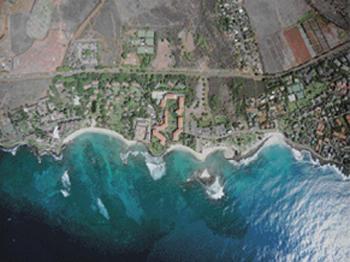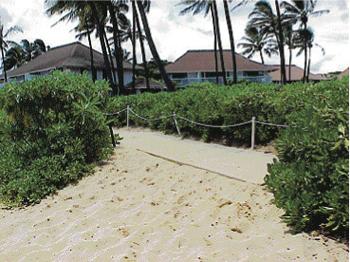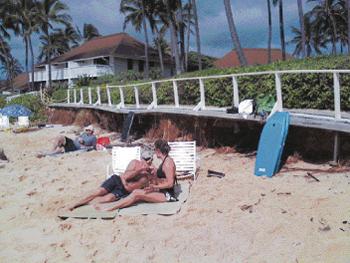LIHU‘E — If Stephen “Dr. Beach” Leatherman went to Po‘ipu Beach Park today, just eight years after naming it the nation’s top beach, he might not recognize the place. That’s the assessment of Jody Kono Kjeldsen, executive director of the
LIHU‘E — If Stephen “Dr. Beach” Leatherman went to Po‘ipu Beach Park today, just eight years after naming it the nation’s top beach, he might not recognize the place.
That’s the assessment of Jody Kono Kjeldsen, executive director of the Po‘ipu Beach Resort Association.
“In all honesty, Po‘ipu Beach isn’t what it used to be,” Kjeldsen told the Kaua‘i County Council last week.
It needs to be fixed for visitors and residents, she said.
“Dr. Beach wouldn’t give the beach the same honor he did several years ago,” she said.
Leatherman is director of Florida International University’s Laboratory for Coastal Research and annually picks the nation’s top beaches based on 50 different criteria. Hanalei Bay won this year’s award.
“It’s not the same beach park anymore,” Councilman Tim Bynum said. “There’s less beach.”
There is much less to love about one of the island’s favorite beaches for visitors and residents, according to coastal geologist Jim O’Connell. Since 1927 it has averaged a foot a year lost to erosion from storms and what he calls “chronic erosion,” or erosion that continues year after year.
That erosion has created dangerous swimming and snorkeling conditions for both residents and visitors, as a stretch of sand, known as a “spit” or “tombolo,” which used to separate the calm side of Po‘ipu Beach Park from what is commonly called the Waiohai side, has also been washed away.
Without that tombolo, the east-to-west current flowing through Po‘ipu Beach Park has nothing to slow it down, and has swept many visitors toward the Sheraton Kaua‘i Resort beach, with the Po‘ipu Beach Park lifeguards called to respond, O’Connell told councilmembers.
Kjeldsen said she receives letters from return visitors complaining about the deteriorating condition of Po‘ipu Beach Park, saying they are seeking other beaches and other islands to visit as a result.
The degradation is affecting aesthetics and beach safety. This is of grave concern to Kjeldsen and PBRA members as surveys of Po‘ipu visitors indicate a trip to the beach is the No. 1 reason for coming to Kaua‘i and Po‘ipu, she said.
“Po‘ipu Beach Park is critical to our industry,” she added.
Kjeldsen said a planned beach-replenishment project stalled three years ago, and her organization is willing to fund portions of a planned replenishment program which, if it moves forward as scheduled, could be completed before the Thanksgiving holiday.
The first phase of a three-phase plan to restore Po‘ipu Beach Park to its top-beach glory involves moving 500 cubic yards of sand to the beach. The sand is currently stored at the Kekaha Landfill.
O’Connell, of the University of Hawai‘i Sea Grant Program, advises the county on coastal matters, with funds from the county.
A shoreline change project involving UH has studied beach erosion (loss) and accretion (gain) around Kaua‘i. It shows that since 1927, Po‘ipu Beach Park has lost around a foot a year.
By using data collected and still being collected, scientists will be able to predict where the shoreline will be in 20, 30 and 50 years, O’Connell said.
Among the goals of the sand-replenishment project at Po‘ipu Beach Park is to reduce the volume and strength of the east-to-west current now flowing through the park’s nearshore waters, he said.
The alternatives are to do nothing, armor (seawall), relocate (move the existing beach mauka), or beach nourishment (adding sand), O’Connell said.
The first phase, adding 500 cubic yards of sand, could be accomplished quickly, with just one state Department of Land and Natural Resources permit required, and no state Department of Health or U.S. Army Corps of Engineers permits required if the sand is added to the beach above the high-water mark, he said.
The second phase involves moving 6,000 cubic yards of sand from Kekaha to Po‘ipu, and the third phase involves a long-term sand search, likely including exploration of offshore, deep-water areas in search of suitable beach sand, he said.
The idea in phase one is “dune nourishment,” or adding sand to the eroding area between the water and the lifeguard tower at Po‘ipu Beach Park, O’Connell said.
Phase two will require a DOH permit, U.S. Army Corps of Engineers permit and, likely, an environmental assessment, he said.
“Sand is a commodity,” said O’Connell, adding that he has no clue why sand on the East Coast costs between $8 and $12 per cubic yard, but sells for $150 to $200 a cubic yard on Kaua‘i.
“Sand is gold on this island,” but for the purposes of this project is free and readily available, the result of a gift from the state when they removed sand for establishment of a bird sanctuary on the Westside, he said.
What is also needed for phase one is a topographic survey for a certified-shoreline study and a minor Special Management Area permit.
After O’Connell’s presentation, Council Chair Kaipo Asing had one of his own, showing both Waimea and Kekaha beaches, with portions of Kekaha losing two feet a year to erosion, and Waimea gaining at about the same level.
His warning: make sure “whatever we do in one place doesn’t adversely affect someplace else,” citing loss of a home on ‘Aliomanu Beach, loss of a restroom building at Kapa‘a Beach Park, and severe erosion at Kapa‘a’s Pono Kai Resort and Wailua Golf Course, mostly due to manmade hardening of the shoreline with seawalls.
Kjeldsen said her association supports all three phases of the project, and Bynum also wants the project to move forward quickly, because of the existing “dramatic changes” and economic impact.
“We all know that nothing moves quickly in Kaua‘i County, or in any county,” Bynum said.




